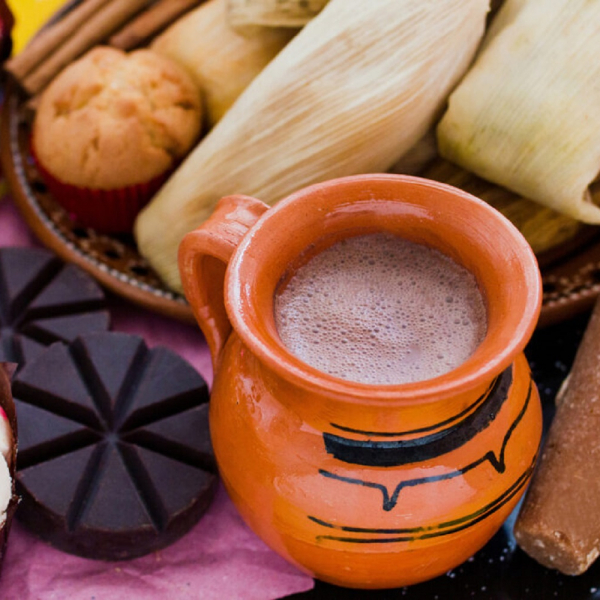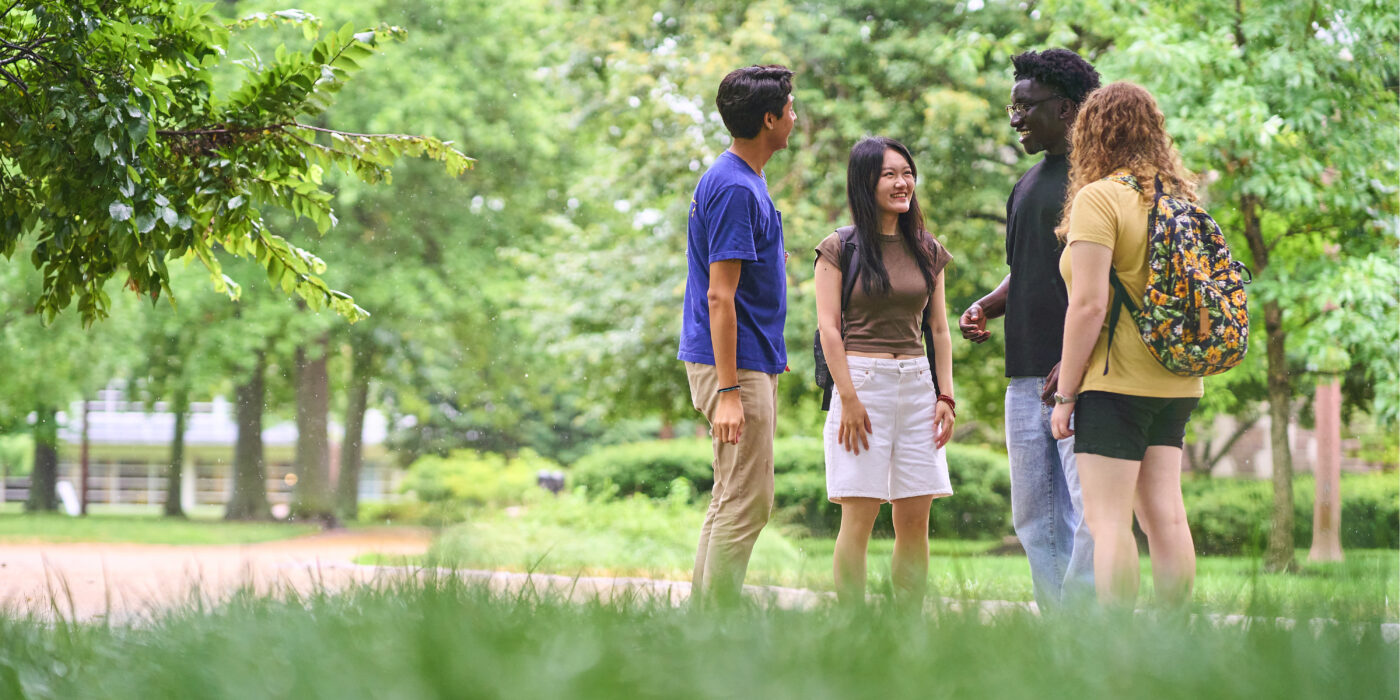
How do we insert empathy into fierce disagreement? What happens when we cannot reach even a compromise, let alone accord? How do we learn to negotiate difference gracefully, preserving the humanity of all? The country — in fact, the entire world — is struggling with those questions.
Here at Washington University, there are big questions to resolve — locally, nationally and globally — with searching, sometimes difficult conversations taking place along the way. Professors, administrators and students are tackling similar challenges in their own fields — from the social and physical sciences to medicine and the arts. Always, they’re working hard to bring clarity, to create community.
As an institution, WashU also has had a long tradition of peaceful protest, wherein tough questions are raised and explored. Chancellor Andrew D. Martin, PhD ’98, who teaches the “Free Speech on Campus” seminar, says that anyone has the right to ask and answer any question, engage in the most complicated issues of the day, disagree profoundly and express their convictions. Yet there must be parameters: One cannot harass or intimidate others, create chaos, instill fear or disrupt the regular life of the university.
When issues become emotionally charged, Martin says, it becomes even more important to stay focused on the university’s missions. First, on WashU’s highest purpose: the creation and dissemination of knowledge, through teaching, research and practice. Second, on the totality — the many thousands of students, faculty and staff — of the university community. Some might burn to speak, but others are overwhelmed, confused or silenced by grief.
“In loco parentis doesn’t exist anymore, but it’s how we approach the work, as if these students are our own. Our job is to love every one of them.”
Chancellor Andrew Martin
Third, but never least, “we focus on the students,” Martin says. “In loco parentis doesn’t exist anymore, but it’s how we approach the work, as if these students are our own. Our job is to love every one of them, even at very fraught moments, like those of the last academic year, where some of our students were arrested on campus. It was our duty to embrace those students — but also to embrace the other students who were affected as well.”
Martin hails from a different, predigital generation of college students: “Sure, we had the telephone, but it hung on a wall in the dormitory. Our evenings were spent in conversation with our classmates about the issues of the day. Today, we are hearing loud and clear, particularly for our students who grew up during the pandemic, that the ability to genuinely listen to the opinions of others is at a real deficit. Yet there’s a real desire among many of our students to get out of the echo chambers created by social media platforms.”
As an institution, WashU’s job is not to pick sides in contentious debates, he continues, but to give students the skills they need to climb out of those chambers — the ability to find trustworthy information, investigate history and context, listen across differences — and dialogue with respect and without attack.
“Our students have grown up during a time of global instability and volatility, and they’re trying to figure out what’s going on,” Martin says. “Tensions with China, a land war in Europe, tragic events in Africa and, of course, the complicated conflict in the Middle East. We’re also approaching a presidential election at a time of unprecedented polarization, which is curated by social media companies to inflame passions because anger sells more clicks.”
The stakes are high for all universities right now, Martin adds. Higher ed has joined the list of other institutions that have lost people’s trust. At many universities, enrollments are declining. And “people, particularly in Washington, D.C., are angry with higher ed. Part of that is political opportunism, but part of it is a real concern that some institutions have lost their way.”
WashU’s future is not as precarious as others. But in a time of general chaos, “students are going to start sorting into places that handle things well.”
During the spring’s protests, WashU was one of the campuses that did not allow tents to go up. “On other campuses, once encampments were set up, things got out of hand,” Martin explains. “Our decision was painful in many ways, but it was the best of a lousy set of options.”
Fortunately, WashU is uncommonly committed to the idea of community, and Martin is confident that it can be preserved. “People here are more present. They show up for one another,” he says. “It drives a level of collaboration in research that you don’t see in many places. This is a place that balances real academic rigor with humanity.”
And as an institution, WashU engages the entire community in examining these big questions. On the next pages, five faculty and staff members share how they’re adding to the conversation and preparing all of us, especially students, to have difficult conversations.
Creating a nurturing environment
Jacob Chacko is executive director of the Center for Diversity and Inclusion and director of Dialogue Across Difference (DxD), an eight-week course for undergrads. DxD teaches the art and skill of navigating difficult conversations on highly charged topics, including politics, religion, race, gender and socioeconomic identity.
When did you first become interested in these conversations?
My lived experience is pretty much conflict! When I was coming to understand my queer identity in high school, I encountered folks opposed to my way of life. As we launch the DxD program here, I recognize student fear: “How do I know there’s a safe space for me to talk about my perspective without feeling attacked?” And I say, “If you are fearful or uncomfortable, there are probably 10 others who are feeling the same way. Come connect.” We create an environment where community is formed, and trust is built.
I imagine that kind of teaching takes many forms.
When we held the Israel-Palestine dialogues, some students said, “I have family in Israel who are affected,” or “I have family in Palestine who no longer have a home.” The pain was raw. So we did both intergroup and intragroup dialogue. Afterward, students said, “I came to this with a staunch understanding that ‘from the river to the sea, Palestine will be free’ meant [x].” For some, it was a full belief; for others, it was antisemitic. No one changed their minds after our dialogue, but they now understood where others were coming from, and why those words could be hurtful.
We’ve also started a program called Dessert and Dialogue, where we discuss different topics each month: what intergroup dialogue looks like; love and relationship; the impact of Sidechat, an anonymous app where students vent; even how to talk through roommate conflicts.
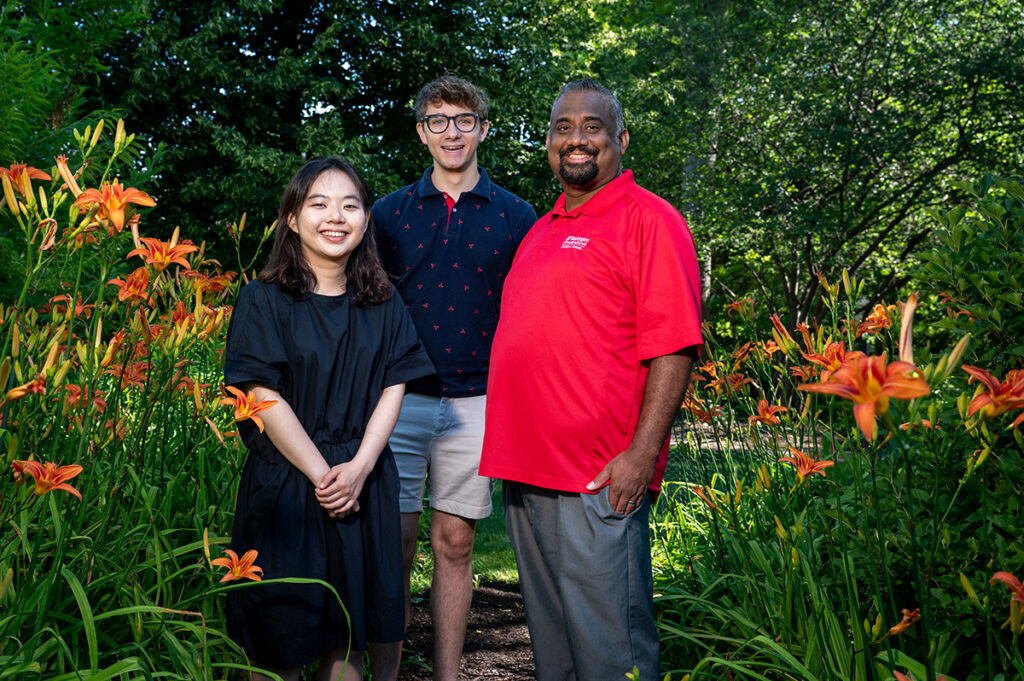
In building skills, where do you start?
With active listening. Understanding where folks are coming from. Knowing the difference between debate, dialogue and discussion. Persuading to the other side is debate. What we do is centered fully on dialogue, where we’re learning from each other’s truth and lived experience.
The ability to ask the type of questions that enable folks to share how they came to a certain belief is a skill students need to learn. It’s something employers are absolutely looking for. You may someday have to work with a team of people who don’t share the same perspectives you hold, but you’ll still have to find a way to get a project done.
What do you see getting in students’ way?
The notion that you are either this or that. You are on the right side of humanity or the wrong side. There’s peer pressure to choose a side — maybe they feel if they are not choosing, they are not living up to their values. But sometimes they have little knowledge or history of what might be happening. Often, the answer is not an easy this or that.
For more than a decade, cancel culture has marked both the left and the right. If you are not fully on board with something, then you are not with us. Tech has advanced in many ways that provoke those divides. It brings both information and misinformation. Sure, times of polarization always existed, but now it’s more in your face. Nothing seems far away, distant, remote. That can make people more rigid because there’s no avoiding it.
You are equipping and training faculty, too?
What’s happening in the world absolutely comes through the classroom, so real dialogue needs to happen. We now have trained faculty/staff facilitators for small groups. At The Longest Table — a meal program hosted by the Gephardt Institute for Civic and Community Engagement, where you eat with people from different walks of life — facilitators who are trained to de-escalate are there helping with dialogue.
In the classroom, it’s a little more controlled. The class works through deciding how they will hold each other accountable when community guidelines are broken.
What results are you seeing?
Students who might never connect with each other under normal circumstances are able to meet and greet. Students are realizing, “Hey, not everybody who holds the views I do thinks the same.” To still hold each other in love and friendship while holding those differences is the goal.
Educating aspiring leaders
Anna Gonzalez, who developed Dialogue Across Difference, is vice chancellor for student affairs — which means listening closely to students, watching over their well-being and offering them hard-earned wisdom.
A big part of your role is recognizing students’ needs. What are they in this fractured time?
In my experience, they need to learn how to step back and view situations from multiple perspectives. To develop the ability to express themselves in a way that is civil, a way other people can hear. And cultivate the ability to listen — by which I mean, really hear one another.
What have you found works?
The Dialogue Across Difference program is working. More than 1,500 students have been touched by the program. The first part of the course focuses on learning how to listen, and that never stops. One student told me it was the best class — and the hardest — she’s ever taken. We held an interfaith dinner, and hundreds of students showed up. They were not forced to go; they chose to go. Also, there was a debate between College Democrats and College Republicans on women’s reproductive rights, and before they came together, they outlined the rules of engagement.
Those things work because people know what to expect. It takes the fear away. And so many students are afraid. They’re afraid of getting doxed. They’re afraid that if they disagree, even in a small group, they’ll be bullied, or someone will put what they said out there on social media or in the newspaper. It makes me sad — and angry. A sense of belonging is critical for our students. No one wants to walk in fear.
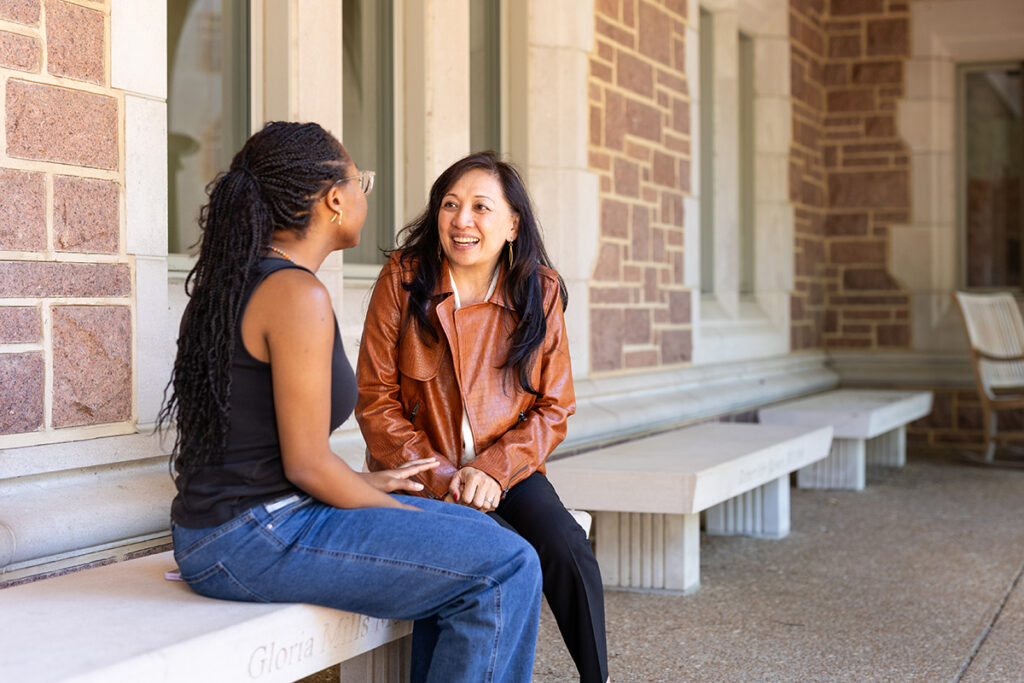
What challenges are students facing?
Loneliness is real. Young people feel lonely and isolated, and they so want to belong. It’s harder now than ever to say no to a mob or a bully. Students need to know they can be their authentic selves and still belong here.
Also, again social media: There are anonymous platforms where you can just throw something out without taking any responsibility for your words. You can be as hurtful and mean as you want without having to engage in a conversation. Students leave thinking they did have a conversation: They said what they thought, and other people were emboldened, so they responded. But this is not a real conversation!
What tips do you offer?
Sometimes it’s OK to take a deep breath and say, “I need a timeout. I can’t engage with you or this issue right now.” Also, we need to help students get excited about learning about history and culture. If you really want to debate or dialogue about the Middle East, for example, you must learn about the Middle East first.
Is part of the problem how complex and daunting today’s issues are?
Yes, and it’s daunting for us, too! WashU’s top leadership has had a slew of training on Islamophobia and antisemitism. Really smart people are there, and they’re taking notes and asking lots of questions. So, yes, it’s daunting — and we cannot give up on it.
What else do you notice in your interactions with students?
They’re curious. They want to learn about differences, about seeing themselves in relation to others, probably more than at any other time in their lives. We put them in such a diverse community — diverse thoughts, experiences, cultural backgrounds. We want that curiosity, that engagement.
And I try my best to give them grace when they make mistakes. They’re still developing, learning how to take responsibility. I tell them that no matter what their intentions are — and I believe they nearly always come from a place of deep care and passion — their actions affect others and can have harmful consequences. The challenge is to bring everyone together and then grapple with how these differences can help build us up as individuals and as a community.
Benefiting from perspectives of individuals from all backgrounds
John Inazu is the Sally D. Danforth Distinguished Professor of Law and Religion. His most recent book is especially apt: Learning to Disagree: The Surprising Path to Navigating Differences With Empathy and Respect. In his book, Inazu succinctly summarizes current obstacles: “We are not very good at disagreement,” he writes. “We view our adversaries not only as wrong but increasingly as evil. We resist notions of forgiveness. And we distrust institutions that try to mediate our disagreements.”
Why are classrooms ideal places to overcome those obstacles?
Because you can have an extended conversation with the same group of people, and you can ask follow-up questions if you are thrown or confused. We can’t expect people to be willing, on day one, to engage across perspectives on emotionally and intellectually complex issues. It takes time to build that trust.
What challenges are WashU’s students — and faculty — facing?
I’m quite inspired by the passion and energy of our undergrads. The challenge they encounter is that they arrive at college and start thinking more deeply about the injustices of the world and want to address them, but they often lack the resources or capacity to do that. Without longer-term strategies that unfold over years or even decades, whatever difference their current actions make will often be limited and fleeting. I think we can do a better job of helping students understand how to make a commitment over a longer period, rather than just in the moment.
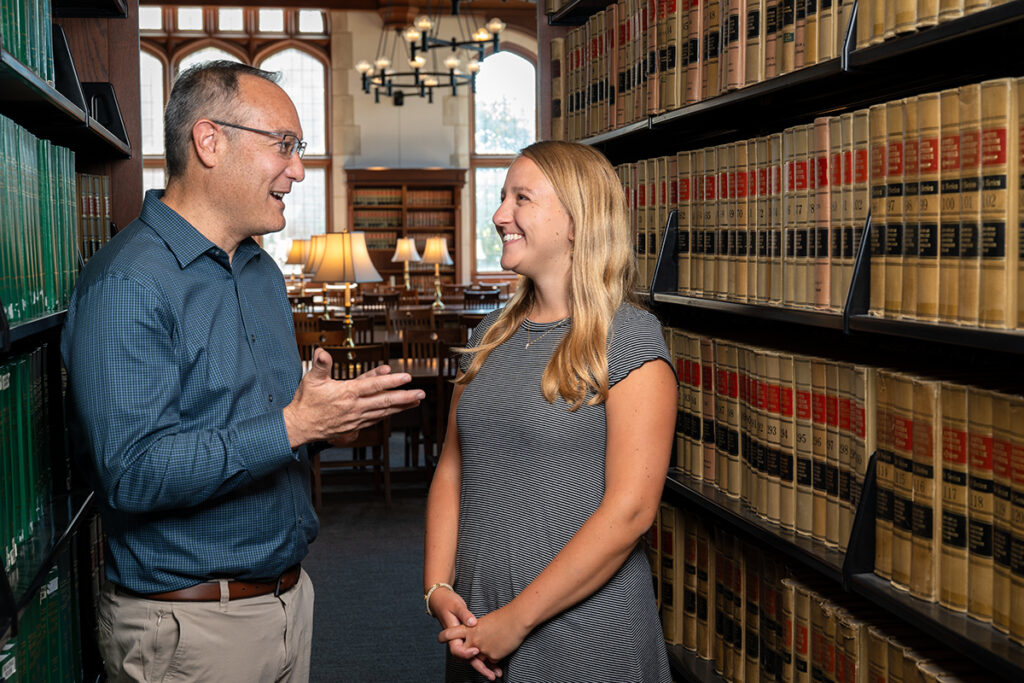
You write that “in addition to its unending distractions, social media also makes it harder to empathize with others.” What can we do about that?
I don’t think we have any choice but to think radically about minimizing or changing our social media habits. We are not going to change the algorithms. They are set up for our worst selves, encouraging interactions that are short and snarky and disembodied.
What else makes it difficult for students to understand or empathize with different viewpoints?
In my experience, some WashU students who lean progressive might not have much lived experience with people who are more conservative. I’ve seen students have trouble imagining why someone might embrace certain viewpoints and ways of life, and that becomes a limit in imagination and understanding. That’s true for faculty as well. But there are also limits to understanding the felt experience of being a racial, sexual or religious minority on campus. It’s easy for people who are in the majority to think, “Well, we have already addressed that,” and not realize it can still be hard, and exhausting, on a daily basis for those in the minority.
How do you suggest someone enter a difficult conversation?
By asking, “What is one thing I can learn from this person? And what might our common ground be?” Also, make sure you are going in emotionally and physically prepared, well-rested, having thought about what might happen. Especially with people close to us, it’s likely that we’re going to hear something that disturbs us. So if you can anticipate that and plan a reaction that is patient and calm and doesn’t take offense, you have an opportunity to change the dynamics of the conversation.
How do you advise students to decide when to engage in the culture fight and when to step back?
Choose your battles. You don’t have to speak truth to every issue. Find a few you care about deeply and learn deeply about those issues. Use this time to become more educated about them. And be attentive to context. It’s rarely productive to get into a disagreement at a large lecture or public event. Save the meaningful interactions for smaller conversations when you can have follow-up.
You write about disagreeing “gracefully.” What does the word mean in this context?
When I think about grace, I think about a kind of softness and compassion in our interactions, reminding ourselves that every person we encounter is a human being with hopes and dreams and insecurities. Grace can let us slow down and be aware of the incredible complexities but also possibilities of the people around us.
Grace also means learning to forgive yourself for making mistakes — and learning to let others make mistakes.
If we are morally confident about a certain stance, are we obligated to persuade others to join us?
A lot of people with political or religious or ideological commitment want to see their views embraced by everyone around them, because they think those views are true and important for a just society. I understand that. But the key is persuasion, not coercion or control. And sometimes persuasion takes a very long time, and we do it in very small and modest ways.
Fully committing to fairness and inclusion
Pamela L. Begay, MSW ’04, is associate professor of practice and director of the Kathryn M. Buder Center for American Indian Studies. She is a member of the Diné (Navajo) Nation and was recently appointed the North American Commissioner of the Indigenous Commission for the International Federation of Social Workers.
Begay’s email signature includes a land acknowledgement — a formal statement that honors a place’s Indigenous people, past and present, and recognizes the history that brought us to where we are today: “The Kathryn M. Buder Center at Washington University in St. Louis occupies the ancestral, traditional and contemporary lands of the Osage Nation, Otoe-Missouria, Illinois Confederacy, Quapaw, Ho-Chunk, Miami and many other tribes as the custodians of the land where we reside, occupy and call home. We recognize their sovereignty was never ceded after unjust removal …”
To the First Nations, land is sacred, alive, deserving of respect. Where do you even begin in trying to convey that?
If I’m giving a land acknowledgement, I’ll talk about the people, the tribes that should be here. We took a trip to Oklahoma, for example, and talked to people from nine tribes. It was important for me to know and recognize them, because this is not my tribal homeland. Everyone got pushed and forced to other states away from Missouri.
The Buder Center received funding from Missouri Humanities, and we made a series of videos, one that included a panel discussion with people from three different tribes. What does it mean to be a person from a tribe that should still be here? What does the land mean and is it proper to do a land acknowledgement, or is it just performative?
Acknowledgement continues by encouraging others to do their own research on tribal removal, tribal sovereignty and the history of the land where they reside.
We created a land acknowledgement template that anyone can use at public events or meetings, but we want them to do their own research, not just rely on the Buder Center. The idea is to get people to act. We ask corporations or other organizations, “What have you researched, and what do you now know?” We are very happy to help, but we encourage people to do this work themselves. And we encourage them to read their acknowledgements themselves — it doesn’t have to be a Native person reading it. It doesn’t have to always fall on Native people to teach other people about us. The research people do themselves is the action — learning is action.

How do you make sure the verbiage isn’t just performative?
We always encourage people to ask: What can I do? What can my/this organization do? So it’s not just performative. How can you partner with Native people to make sure they are seen and not invisible in the process? How can you support Native causes, consider a Native scholarship, partner with tribes in recruitment?
What progress are you seeing here on campus?
Departments and schools are adding similar land acknowledgements to their email signatures and websites. One example of action is that various departments have sponsored and offered to help pay rental fees for the annual Powwow that brings Native people back to their ancestral homeland here in St. Louis, the land here at Washington University. Our Buder Scholars are in the community, and this past year spoke to the first-year medical students about land, discussing Native wisdom and land as the source of medicine. The Buder Center at the Brown School does a lot of recruitment, letting people know about the Buder scholarship for graduate study in social work and looking for Native tribes that could be practicum sites for our students.
We must also keep in mind that we are only 2% of the general population. People ask, “Why aren’t there more Native students and Native faculty?” Well, there’s only 2% of us left.
Are you seeing similar responses at other universities?
When you talk about social justice and the importance of people and the dignity of people, that is embedded in social work’s code of ethics. Last summer, I had a few students working on their practicum through the Buder Center. And I wanted to know what other schools of social work had land acknowledgements. Some did — but it’s probably less than one-fourth. So why don’t the others? Especially universities that are benefiting from stolen land where these universities across the country stand. Miami University in Ohio gives tuition waivers to members of the Miami tribe who are accepted to the school. Other schools have committed to free tuition for any Native students. But there’s so much more work to be done. It’s 2024, and we are barely in a space of talking about it, but let’s act.
Discovering global history and knowledge
Tabea Alexa Linhard is director and professor of global studies and professor of Spanish and comparative literature (by courtesy). She teaches students how to understand the historical, social and cultural contexts of highly charged issues.
There are many points of tension these days, but Israel and Gaza have risen to the top. Why didn’t the war in Ukraine?
Or the humanitarian crisis in South Sudan? I don’t have an answer for this question, mainly because there are many and often contradicting reasons for this. It’s not just the role of the U.S. in the conflict; or social media; or colonialism; or global inequalities; or the loss of life; or the destruction of schools, universities and of a future; or antisemitism or Islamophobia. Unpacking any of these reasons takes expertise and patience.
I do think that sometimes the history of the 20th century can feel very far away to students born in the early 2000s. A clearer sense of that history will not make the debates about the war any less intense, but perhaps more productive.
How do you respond, in the classroom, to current news?
When the war in Ukraine broke out, I was teaching a class called “War, Migration, and Human Rights.” I’d had no intention of teaching anything about Ukraine or Russia, but it felt like my responsibility to address it. So I changed the syllabus and added a limited reading list with works from Ukrainian authors.
What we as faculty can do is not provide the answers — because we don’t have them either — but help students ask questions and then point them to scholars who have reflected on the history, the context and the causes of current events, and encourage them to review trustworthy information.
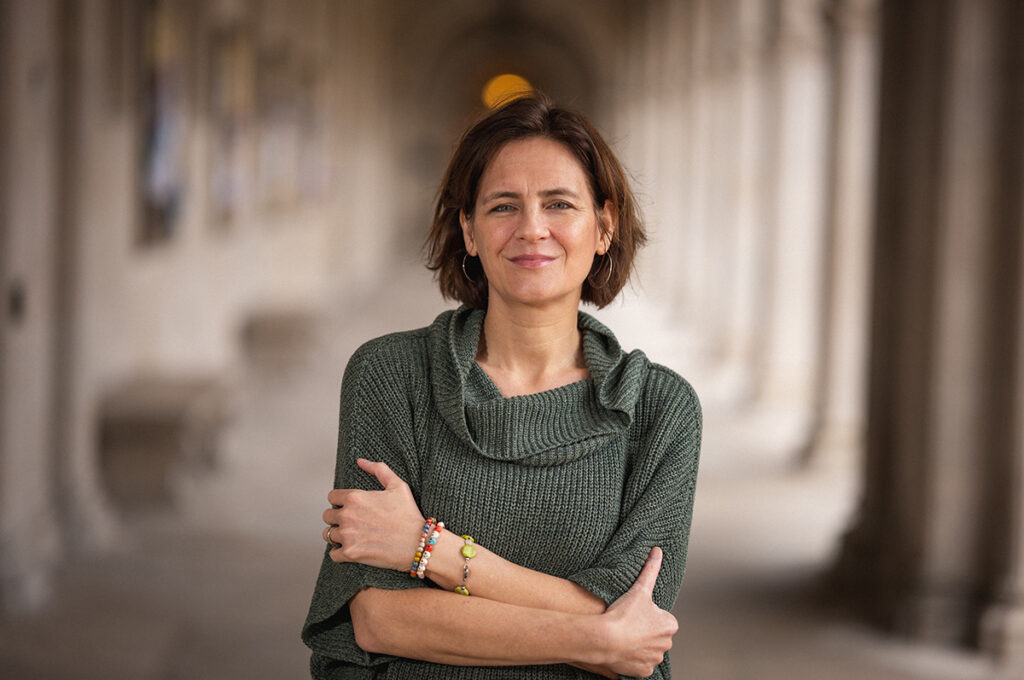
How did you handle Oct. 7, 2023?
In my “Global Futures” course, “How to write about human rights in the 21st century” was on the syllabus for the first class after Oct. 7. I changed what was meant to be an interactive discussion to a quiet reflection. I presented several questions and then requested students to write their answers. I did not want to ask them to speak in front of everybody else so soon after the events of that day — but I didn’t want to ignore it either. Time will tell whether that was the right or the wrong approach.
Where do students generally get their news?
The sense I get is that they trust social media more — and social media often appeals to emotion more than facts. Some do not trust the news media at all. But there are certain sources to be trusted, if never wholly. One of our guest speakers in “Global Futures” was journalist Aryn Baker [the senior international climate and environment correspondent at TIME]. When a student inquired about trust, she suggested looking to sources that stay accountable and acknowledge any reporting mistakes. One thing we can do as faculty is help students question, but also think about moments when the information they receive can be trusted. The representation of migration in the media, for example, can be flawed and dehumanizing — but in which media? Not all outlets are the same.
Where are students emotionally these days?
In a very difficult place. This is the generation that went through COVID and through the routines of active shooter drills in their schools. As digital natives, with social media amplifying all kinds of emotions, they also may feel isolated. But there is much I admire about them: their empathy, their commitment to protect the environment and even to protest.
How do you help them understand current events?
My first instinct is to tell them to take classes with faculty experts — and, fortunately, we have many, working in different disciplines and teaching a variety of courses. Again, find trustworthy sources of information. Read opposing points of view and see what their arguments are, what their sources are. As faculty, we can give students an opportunity to understand where these big issues and conflicts come from, help them understand their history. But students should come to their own conclusions.
And how do you help students not feel overwhelmed?
One of the things I tell students, wherever they’re from, is not to tell the end of a story before it actually happens. In other words, don’t think you have all the answers before you start reading. And don’t try to find one theory that explains everything. Remember that when you talk about these big problems, you are talking about people, about people’s lives. And people are flawed and make many mistakes, regardless of how good their intentions may be.
For example, those who move people across borders today may be part of cartels. They may be involved in human trafficking. But they also may be ordinary people who find themselves in precarious situations, and it’s important not to demonize them, especially in the absence of additional information about their paths. Think about individuals who fled from Fascist-occupied Europe during World War II. Those who made it out did so with the support of others, the “passeurs,” who are now considered heroes and rescuers. But these heroes were also flawed and complicated, and they did all kinds of things that were entirely illegal: They forged documents, paid bribes, helped refugees to cross borders illegally. Yet we would not consider those refugees to be illegal immigrants.
Is this an especially hard time to teach?
Even before this moment, there was a bit of a panic about trigger warnings. Sometimes I heard statements, not necessarily from faculty, along the lines of: “We cannot teach anything anymore; all our students require trigger warnings.” I don’t think that this is true, or at least I have not seen it. Our students are a lot less fragile than many may think. They do not shy away from asking good questions about difficult topics. I’ve taught about the Holocaust, about sex, about violence and death, and I have not had any issues or complaints. When I teach Spanish or Latin American literature, I sometimes hear comments like: “Latin American literature is all about violence, sex and death!” And I respond, “Yeah, all of literature is. You just haven’t read the rest yet.”


